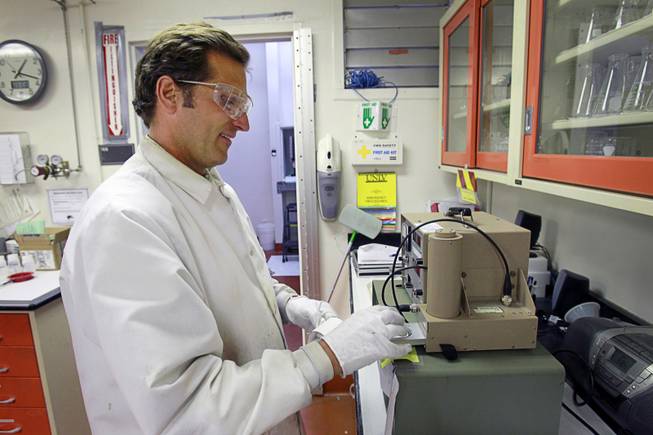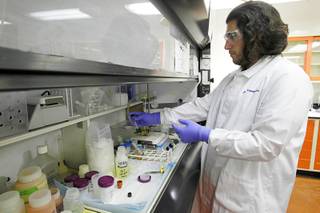
UNLV program radiochemistry director Ken Czerwinski checks for radioactive contamination before leaving a radiochemistry lab at UNLV Wednesday, May 30, 2012.
Thursday, May 31, 2012 | 2 a.m.
Deep in the heart of the UNLV campus, down windowless hallways and in laboratories teeming with beakers, centrifuges and Geiger counters, the element technetium has become an object of intense fascination for researchers.
The element, number 43 on the periodic table, is one of the largest forms of radioactive waste generated by nuclear reactors. Its isotopes have wide-ranging applications that are just beginning to be discovered, most notably in the field of nuclear medicine, but for a team of UNLV researchers toiling in the long shadow of Yucca Mountain, perhaps the most important question is how to store technetium safely.
To further that goal, two UNLV research teams recently received a $1.6 million U.S. Department of Energy grant to fund three more years of research into new storage methods that will neutralize the radioactive element and make it safe for long-term storage.
“One option, which we’re doing now, is the ‘no’ option. We’re leaving it at the reactors, and there’s debate about the effects of that. Maybe what we’ll do is take the fuel, put it somewhere and not do anything with it,” said Ken Czerwinski, a radiochemistry professor leading one of the grant-receiving research teams. “What we’re interested in is trying to make technetium into a metal and storing it as a metal.”
Ideally, that metal, which would be an alloy of technetium and another metal, would not be radioactive and could be stored safely, Czerwinski said.
A separate team, led by research professor Thomas Hartmann, also was funded by the grant and will be exploring ways to store technetium safely in different ceramic materials, including specialized forms of glass.
UNLV received the grant in part because of its expertise in handling technetium, something few other universities around the country can match.
The nuclear technologies program at UNLV, which includes research into radiochemistry, nuclear forensics and radiopharmacology — the use of radioactive elements to diagnose and treat diseases — is one of the leading programs of its kind in the country. Only two other universities in the United States, Missouri and Washington State, conduct similar research, Hartmann said.
A part of the Harry Reid Center for Environmental Studies, which also conducts environmental and renewable energy research, UNLV’s nuclear technologies program has flourished over the last decade thanks to a $40 million cash infusion from the Department of Energy to study the effects of using Yucca Mountain as a nuclear waste dump.
Although plans for Yucca Mountain are currently on hold, the university is continuing to expand its nuclear research efforts, with plans to open a particle accelerator on campus this fall.
“Now that the Yucca Mountain project is finished, we’re focusing more on the nuclear technology side,” said Oliver Hemmers, executive director of the Harry Reid Center. “There’s a huge demand for understanding the chemistry of those materials that reaches far beyond just nuclear waste.”
The center, which does not rely on state money and is largely funded by grants, is currently recruiting three new professors, Hemmers said, and is exploring ways of partnering with outside industries to continue growing its nuclear research programs.


Join the Discussion:
Check this out for a full explanation of our conversion to the LiveFyre commenting system and instructions on how to sign up for an account.
Full comments policy